Where are Vacation Homes Located in the US?
As of 2023, the US has around 142.3 million housing units: roughly one home for every 2.4 people in the country. The vast majority of these homes – 127.5 million – are occupied. The remaining 14.8 million homes are vacant. Of these, around 4.8 million homes, or around 3.5% of the total, are vacant because they’re seasonal, or vacation, homes.
I’ve spent a lot of time writing about patterns of housing and home construction in the US, but virtually none of it has been looking at vacation homes specifically. I wanted to better understand patterns in the distribution of vacation homes in the US, for a few different reasons:
It tells us about patterns of recreation in the US: where are the popular vacation spots?
It tells us about patterns of elite consumption in the US: where do people who can afford it have second homes?
It points us to places that might have unique housing challenges due to very high demand from vacationers and tourists.
To look at US vacation homes, I used Census data, which tracks (to varying degrees of success, depending on the census year) the number of seasonal homes in the US going back to the 1940s.1
Vacation homes in the US
The map below shows vacation homes in the US by state.
Florida leads the pack with over 800k vacation homes, followed by California at 360k and New York at 309k. Michigan (at 260k) and Texas (at 201k) round out the top five. At the bottom of the list, you have several Great Plains states: Kansas at 12.9k, South Dakota at 13.7k, and North Dakota at 11.6k.
There’s a few interesting patterns observable on this map — the dominance of Florida, the relative popularity of Midwest states like Michican and Wisconsin as a place for vacation homes, the fact that Alaska has nearly as many vacation homes as Hawaii — but to a large extent this map is a population map. 4 of the top 5 states for vacation homes are also in the top 5 by overall population (only Michigan breaks this trend, coming in at number 10 in overall population). To account for this, we can look at the fraction of homes in each state that are vacation homes.
By percentages, the pattern changes somewhat. Florida still ranks highly, with over 8% vacation homes, but it's soundly beaten by the New England states of Maine, New Hampshire, and Vermont, which have 15.6%, 10.2%, and 15.1% vacation homes respectively. Even Delaware (8.6%) and Alaska (8.9%) have a greater fraction of vacation homes than Florida does. Michigan (5.7%) is now closer to the middle of the pack, along with places like Idaho (6.2%) and Arizona (5.5%). Great Plains states are still near the bottom (Kansas at 1%, Nebraska at 1.8%), but the state with the lowest fraction of vacation homes is actually Illinois at 0.8%.
At a high level, vacation homes are common in a few geographic regions: New England (Maine, New Hampshire, Vermont), the upper Midwest (Minnesota, Wisconsin, Michigan), the Southeast (Florida, the Carolinas), and the Western states between the Great Plains and the West Coast (Wyoming, Idaho, Utah, Arizona).
How have these patterns changed over time? The chart below shows the total number of vacation homes by state and year.
And this chart shows the fraction of homes that are seasonal by state over time:
Some states have always been popular places to have vacation homes: Vermont, New Hampshire, and Maine have led the pack continuously since the 1940s. Some states have gotten more popular over time. Florida and Arizona increased in popularity substantially between 1960 and 1990, presumably due to the spread of air conditioning (and the construction of places like Disney World). Western states like Montana, Idaho, and Wyoming also get more popular over time.
And a few states have gone down in popularity. New Jersey, Rhode Island, and Connecticut have all fallen in the fraction of homes that are vacation homes. But most states have stayed at relatively similar fractions of vacation homes over time, outside of a broad trend of vacation homes getting more popular in the US as a whole and percentages gradually ticking up everywhere.
Vacation homes by census tract
State-level data can reveal broad patterns in seasonal homes in the US, but we can get a better sense of where specifically the popular vacation spots are by looking at more granular data. The map below shows every census tract in the US where vacation homes are 20% or more of the total number of housing units. This is a small fraction of overall census tracts — 3,372 out of over 85,000 census tracts in the US, or around 4% of the total. But 53% of all vacation homes in the US are in such tracts.2 (Almost 20% of vacation homes are in census tracts where more than 50% of the homes are vacation homes.)
(click to enlarge)
Looking at our census tract map, we see the same patterns we saw in our state-level map — high concentrations of seasonal homes in Florida, New England, the upper Midwest, and certain Western states — but we now see much more detail. Vacation homes in Florida are concentrated on the coasts, and to a lesser extent in central Florida, near Disney and other theme parks like Universal Studios. Vacation homes in the upper Midwest states of Michigan, Wisconsin and Minnesota are concentrated in the top half of those states.
Broadly, looking at this census tract map, we see vacation homes concentrated in a few types of geographies.
On the beach
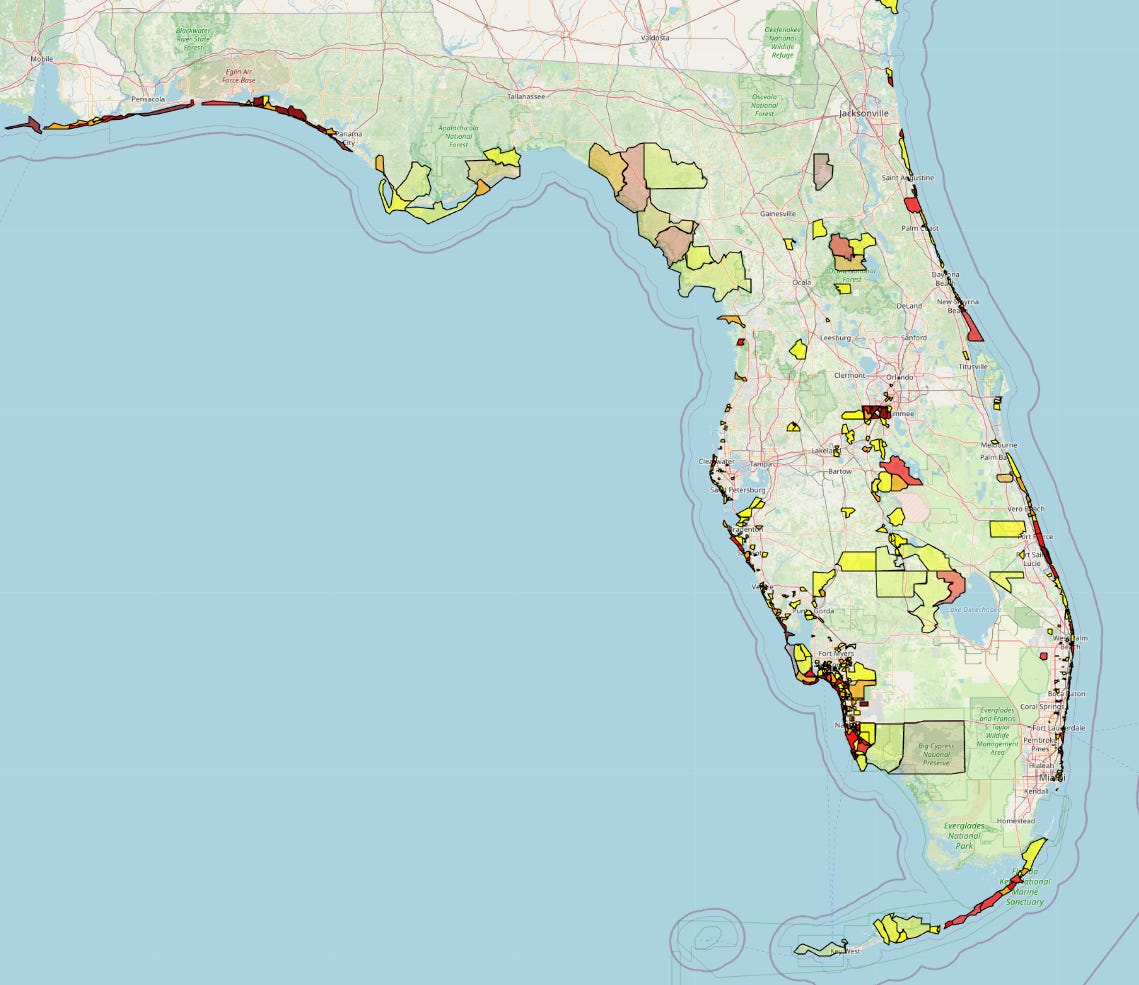
Around 1.2 million vacation homes in the US, slightly more than 1/4th of the total, are in census tracts within 5 kilometers of the ocean. Virtually the entire East and Gulf Coasts are lined with vacation homes. Interestingly, this is somewhat less true of the West Coast. There are still many coastal census tracts with large fractions of vacation homes, but there are many fewer than on the East Coast. Florida has 1.5 to 2.5 times California’s coastline (depending on how you calculate it), and around 60% of its population, but around 5.6 times as many ocean-adjacent vacation homes. In fact, both New Jersey and Massachusetts have more coastal vacation homes than California does. In the continental US, there are roughly 5 times as many vacation homes on the Atlantic coast as there are on the Pacific coast.
On the lake
There are also a large number of vacation homes around lakes both big and small in the US. There are over 160,000 vacation homes near the Great Lakes, around 30,000 near Lake Tahoe in California/Nevada, another 30,000 near Lake of the Ozarks in Missouri, and 12,000 vacation homes near Lake Champlain in New York/Vermont. Altogether there are around 280,000 vacation homes near the 50 largest lakes in the US, and 37 states have a lake, pond, or reservoir with at least 1,000 vacation homes in its vicinity.3
And outside of large lakes, states often have numerous small lakes lined with vacation homes. In large part, this explains why Minnesota, Wisconsin, and Michigan have such large numbers of seasonal homes. Each state has a large number of lakes (2nd, 6th, and 8th-most in the country, respectively), which are frequently lined with summer lakehouses. Around 1.3 million vacation homes in the US are near a lake, pond, or reservoir at least 3 km^2 in size. (A lake this size is big enough to have several hundred vacation homes around it.)
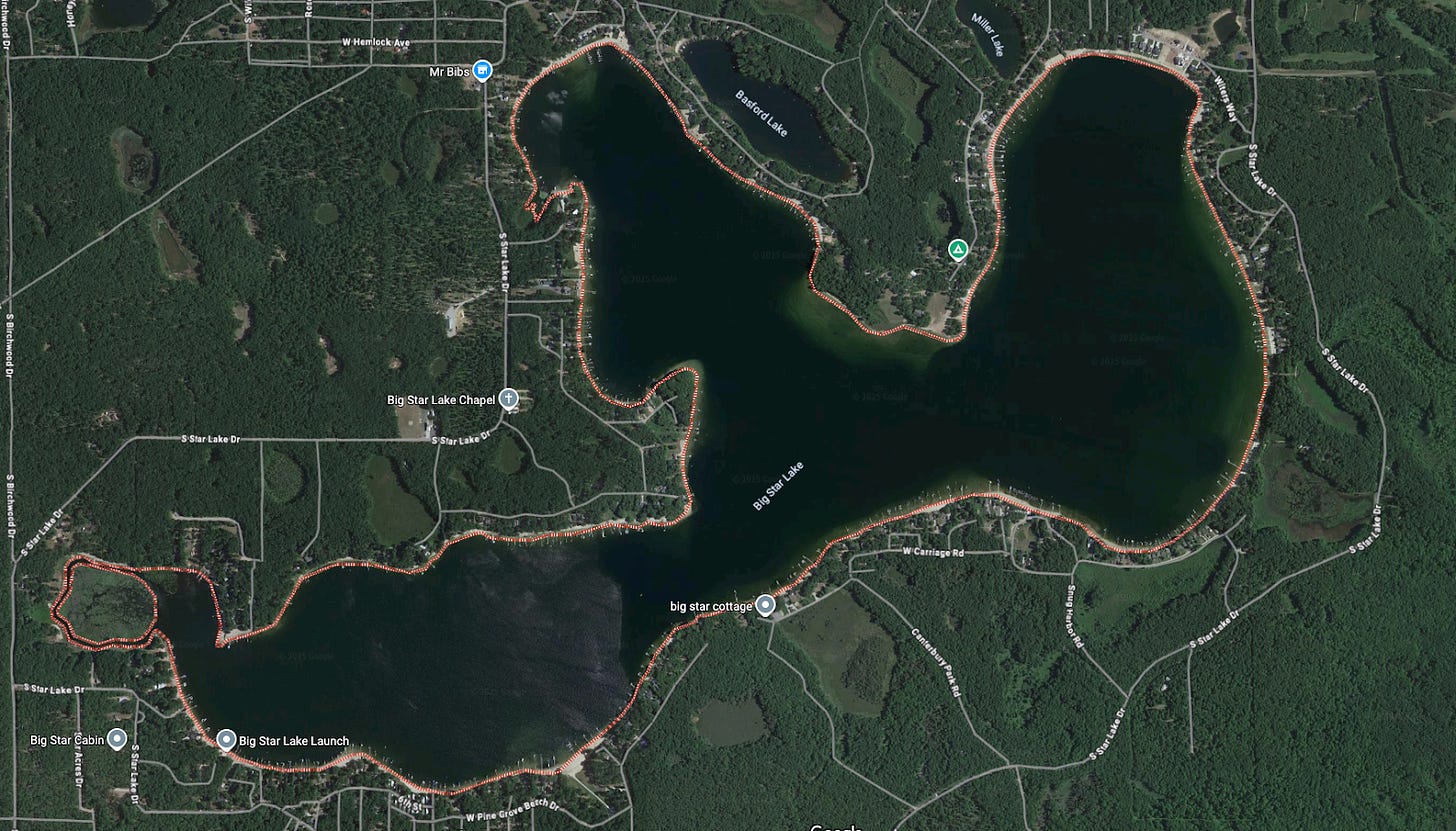
Near skiing
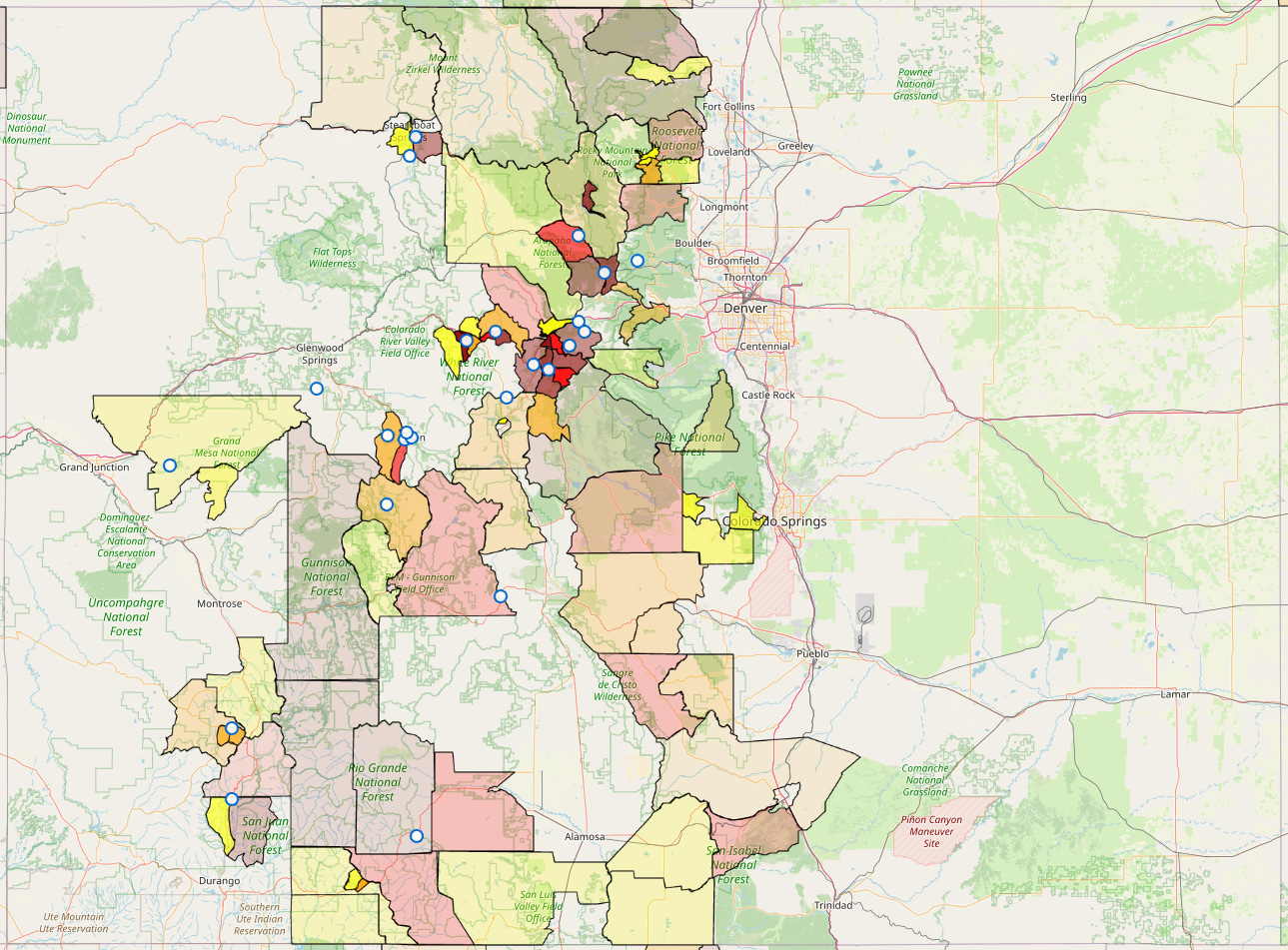
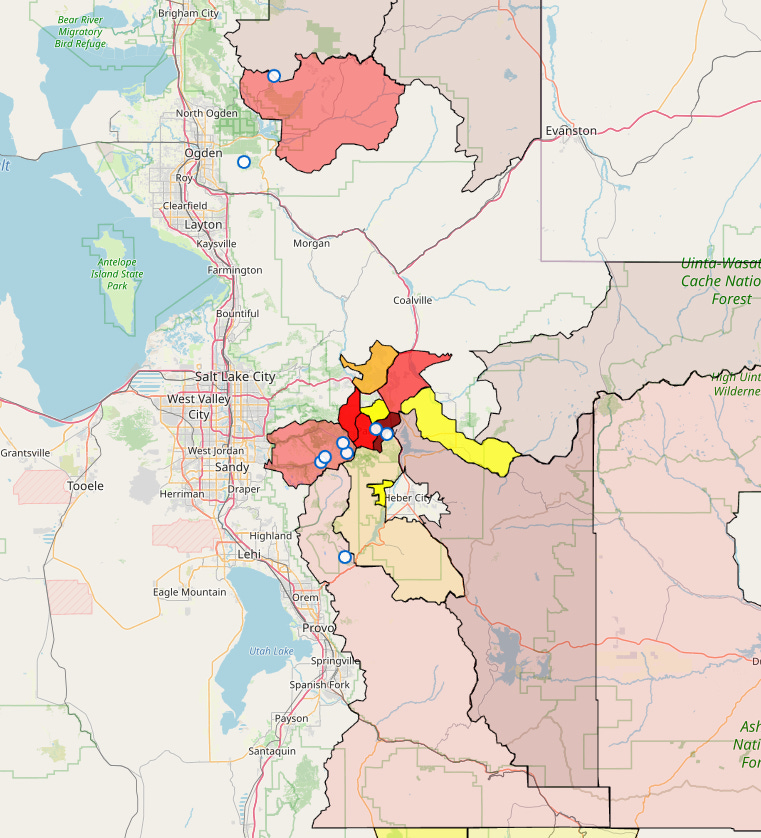
Looking closely at the census tract map reveals that many clusters of vacation homes are near ski resorts: Aspen and Vail in Colorado, Lake Placid in New York, east of Salt Lake City in Utah. The pattern of high-vacation home census tracts overlaps nicely with the distribution of ski resorts in the US. The map below shows our census tracts with large fractions of vacation homes, along with the 200 biggest ski resorts in the US as listed by skiresort.info.4
(click to enlarge)
You can see that most large ski resorts are surrounded by census tracts with lots of vacation homes, and that many of the large regional vacation home clusters — the northeast, the west, and even the upper midwest to some extent — overlap with the location of ski resorts. Overall there are around 380,000 vacation homes in census tracts that are within 5 miles of a major ski resort.5
Mountains, golf, theme parks
Outside these three major categories, you also see large numbers of vacation homes near certain other amenities. Some are located near mountains outside of ski resorts. The southern Appalachians, for instance, have large numbers of vacation homes in places like Blue Ridge, Georgia, Gatlinburg, Tennessee, and Black Mountain, North Carolina.
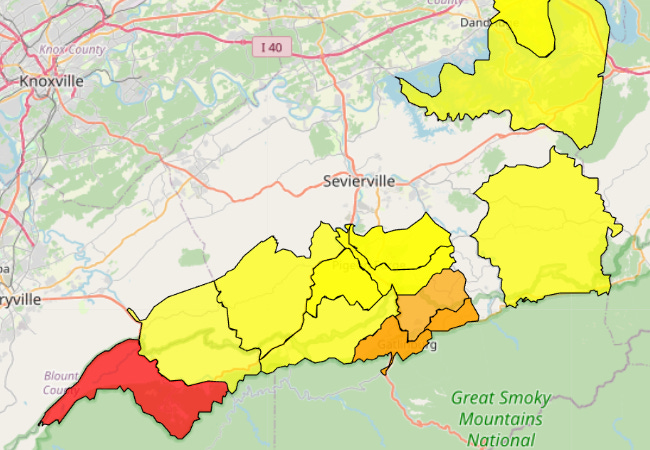
Golf appears to be another major amenity for a lot of seasonal homes. Popular vacation spots like Hilton Head in South Carolina, Long Island in New York, the Highlands in North Carolina, and Palm Springs in California all have very large numbers of golf courses. There are almost 90,000 vacation homes near 20 of the largest golf resorts in the US.
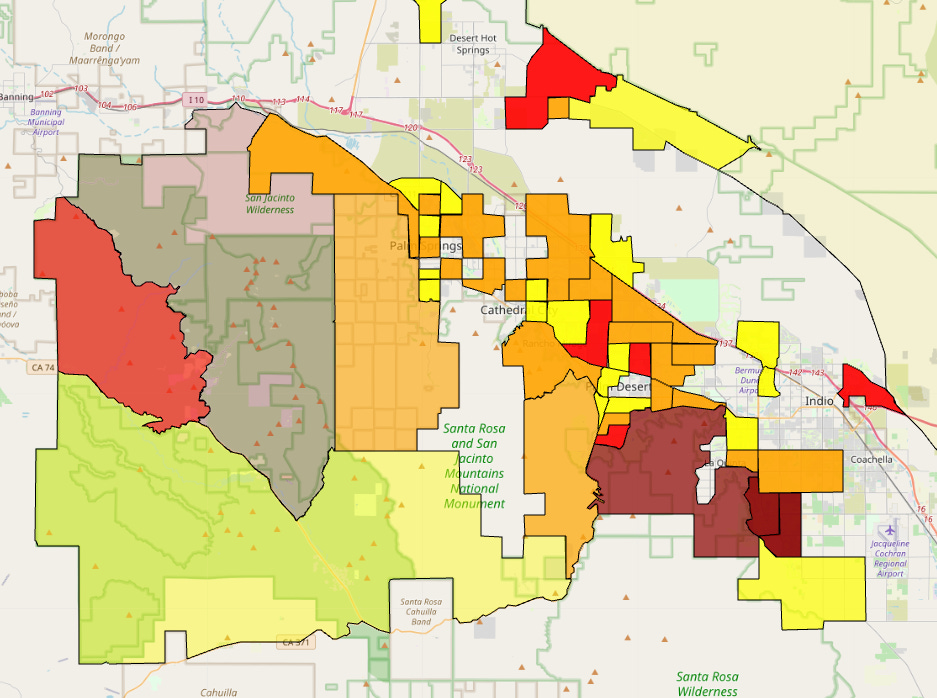
And finally, there are tens of thousands of seasonal homes near Walt Disney World and the central Florida theme parks. (Possibly there are other theme parks that are enough of a draw to generate the construction of vacation homes, though given how dominant Disney and central Florida are in theme park traffic in the US, this would surprise me.)
Major cities
You might expect major cities to be another popular place to have a vacation home; people certainly like taking vacations to big cities, after all. But while major cities do have substantial numbers of vacation homes, proportionally the numbers are surprisingly small. Only New York City has more than 50,000 vacation homes: in other words, 75% of the vacation homes in New York state are outside of NYC.6 Only three major cities in the US have more than 20,000 vacation homes: even a major tourist destination like Las Vegas only has around 19,000. Altogether, the 50 largest cities in the US only have around 350,000 vacation homes in their vicinity (fewer than the number of vacation homes around ski resorts), and the proportion of vacation homes in said cities is substantially lower than the national average (around 1%, compared to around 3.4% in the US as a whole).7
Conclusion
So what are my overall takeaways from this tour of the US’s vacation homes?
Popular vacation home locations tend to remain popular. Most states that have large proportions of vacation homes have maintained that status over time. The three states with the largest ratios of vacation homes, Maine, Vermont, and New Hampshire, have been the leaders since at least the 1940s.
This shouldn’t be that surprising. Places are popular sites for vacation homes in large part due to geographic amenities — the climate, the beach, the mountains — or the activities that those geographic amenities allow (golf, skiing) and those amenities typically don’t change over time. The big exception to this trend, the rise of Florida as a vacation destination (and the South more generally), can be thought of as resulting from a change that did occur in geographic amenities, in the form of air conditioning making the climate much more tolerable.
Vacation homes are highly concentrated. Most vacation homes (> 50%) are in a relatively small fraction of census tracts, and are concentrated in a few geographic regions of the country (the coasts, the Great Lakes, New England, some western states). Similarly, vacation homes tend to be clustered near similar types of amenities. A large fraction of vacation homes are near a large body of water like an ocean or a lake, or are near mountains/skiing.
This is another consequence of the geographic nature of seasonal home construction: climate/natural amenities vary by location, some areas will have much more attractive amenities than other places, and they will accumulate a disproportionate share of vacationers.
Growth in vacation homes is slower than the trend of economic growth might suggest. Between 1940 and 2010, GDP per capita in the US increased by a factor of nearly five in real terms, and the median household income increased by a factor of around 2.5 (also in real terms) between 1953 and 2020. Naively, you might expect the fraction of vacation homes to have increased at comparable rates. But in fact, the fraction of vacation homes in the US has lagged this significantly.
This is another consequence of the lack of improvement in construction productivity, and the fact that zoning rules and land use restrictions makes it so difficult to build homes. We have fewer seasonal homes than we would if construction was cheap and building homes easy, and anyone who wanted one could afford a second home.
The 1970 and 1980 censuses of housing have implausibly small numbers of vacation homes for reasons which aren’t clear to me. According to the 1970 census, the number of seasonal homes declined from 1.7 million in 1960 to 1 million in 1970, which I’m almost certain is an error. 1980 shows similar low numbers. I’ve excluded those years from analysis.
This isn’t because the population is concentrated in a small number of census tracts more generally. Census tracts are sized so they (very roughly) have similar amounts of people in each one, and distribution of population in them is not particularly asymmetric. The 8,000 most populous census tracts in the US only have around 18% of the total US population.
“Near” meaning “In a census tract that intersects with a body of water at least 3 square kilomters in size”, or within 5 kilometers of a body of water at least 50 square kilometers in size. Because some large census tracts will end up having vacation homes that aren’t anywhere near the body of water in question, this will include some vacation homes that aren’t actually near a lake. But it will also exclude some vacation homes that are near smaller bodies of water (or have been subdivided by the census into smaller bodies), so on balance I don’t expect this to introduce too much error.
“Biggest” refers to total length of ski runs, not attendance.
Some of these homes are also near major bodies of water, such as the homes around Lake Tahoe, and some of the resorts in Michigan. If you exclude homes we’ve already counted as being near a major body of water, you get around 270,000 additional homes.
Measured by looking at all census tracts within 12 miles of the approximate center of the city.


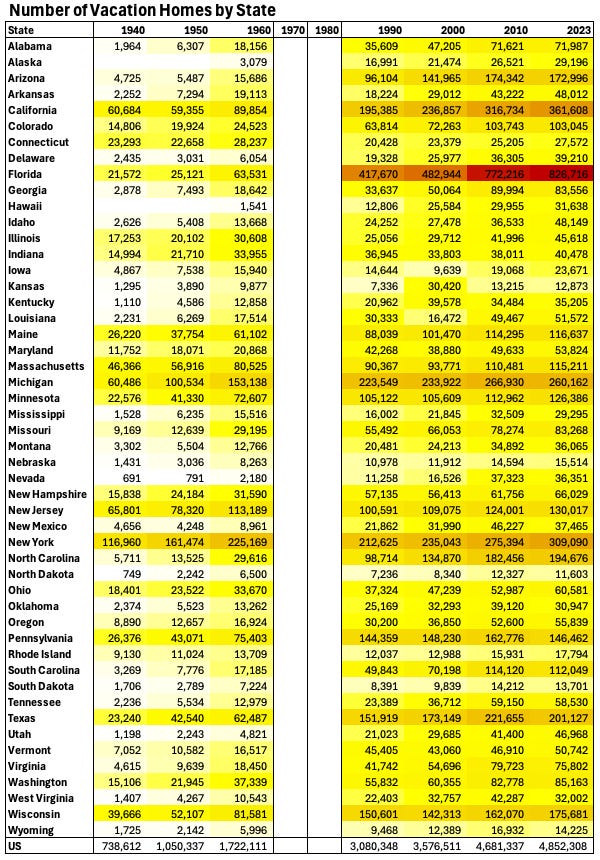
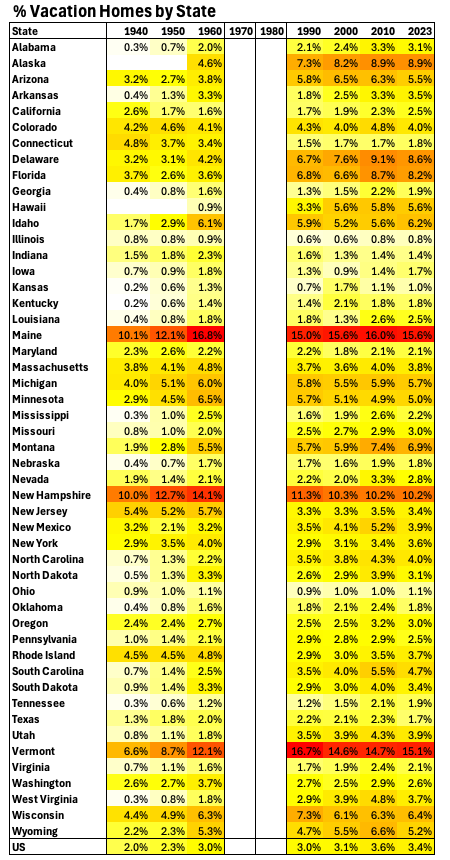
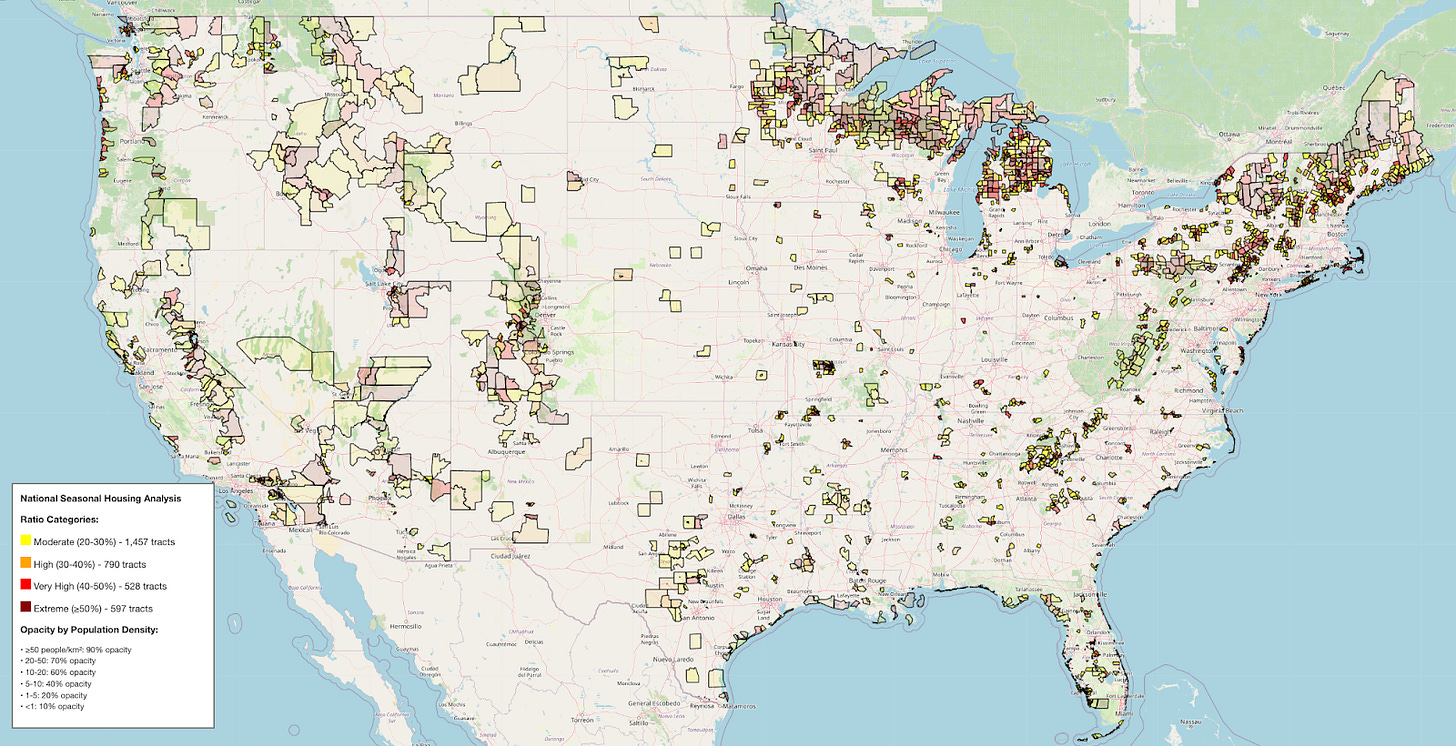
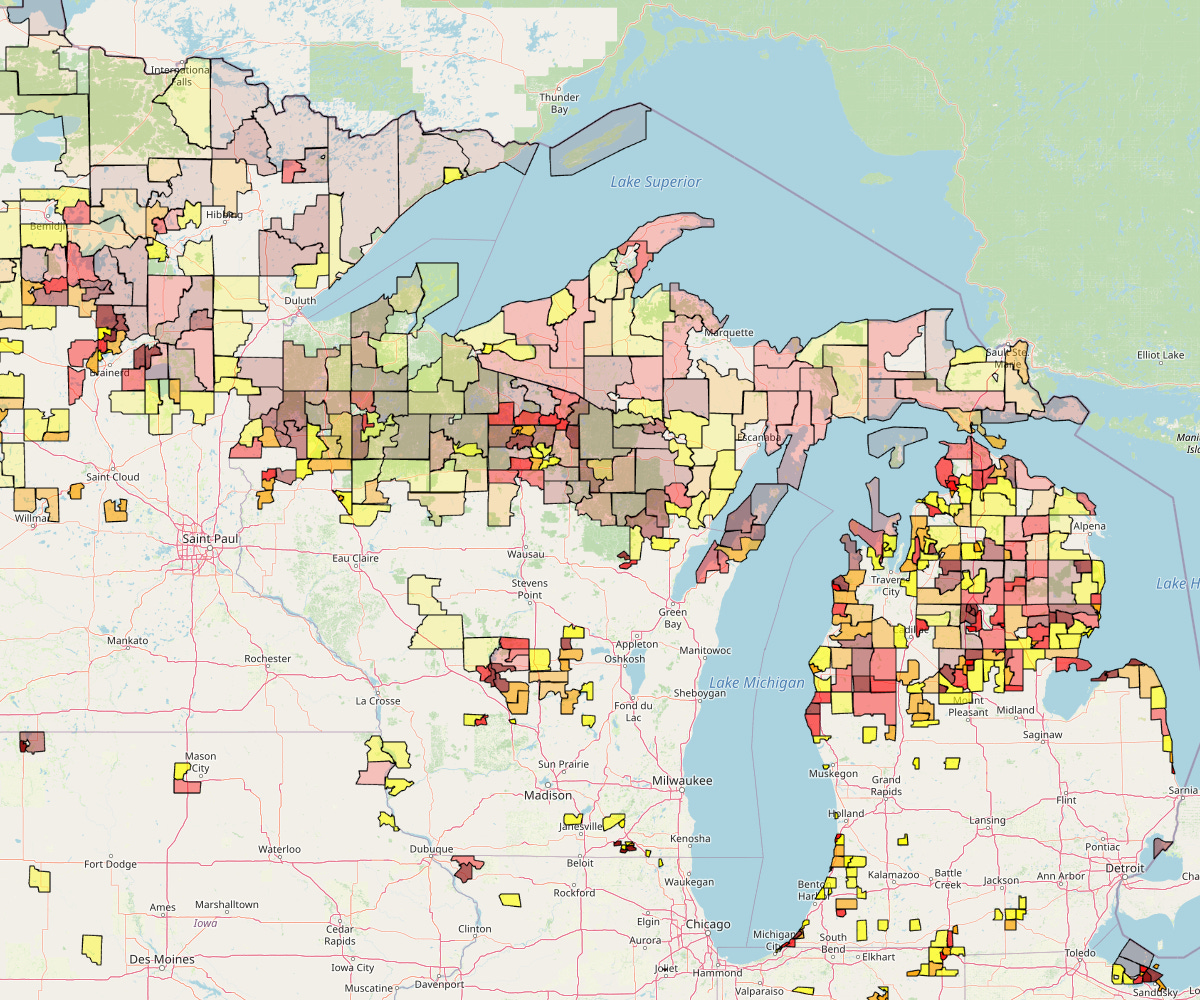
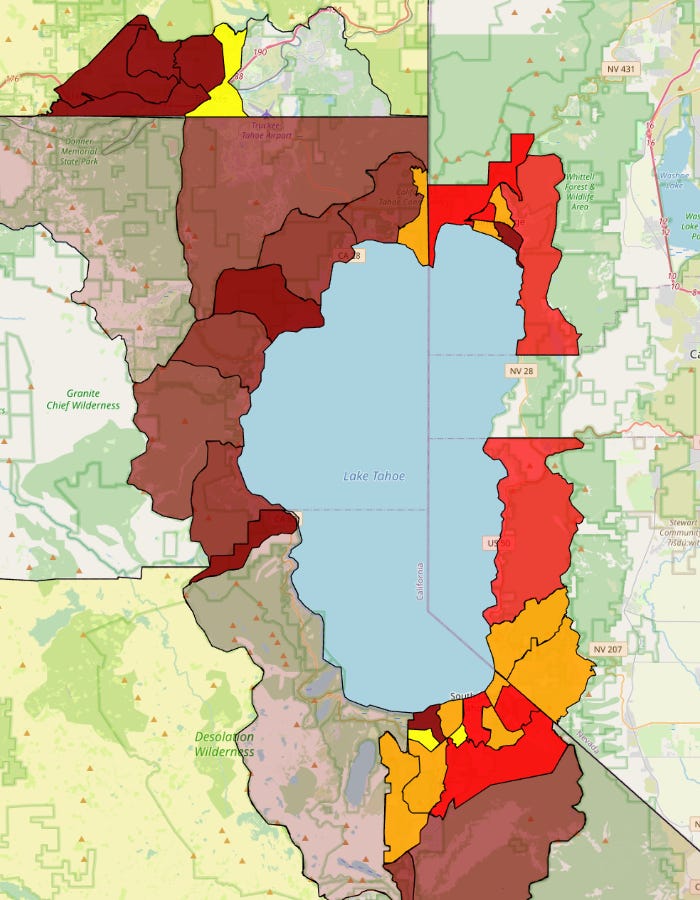
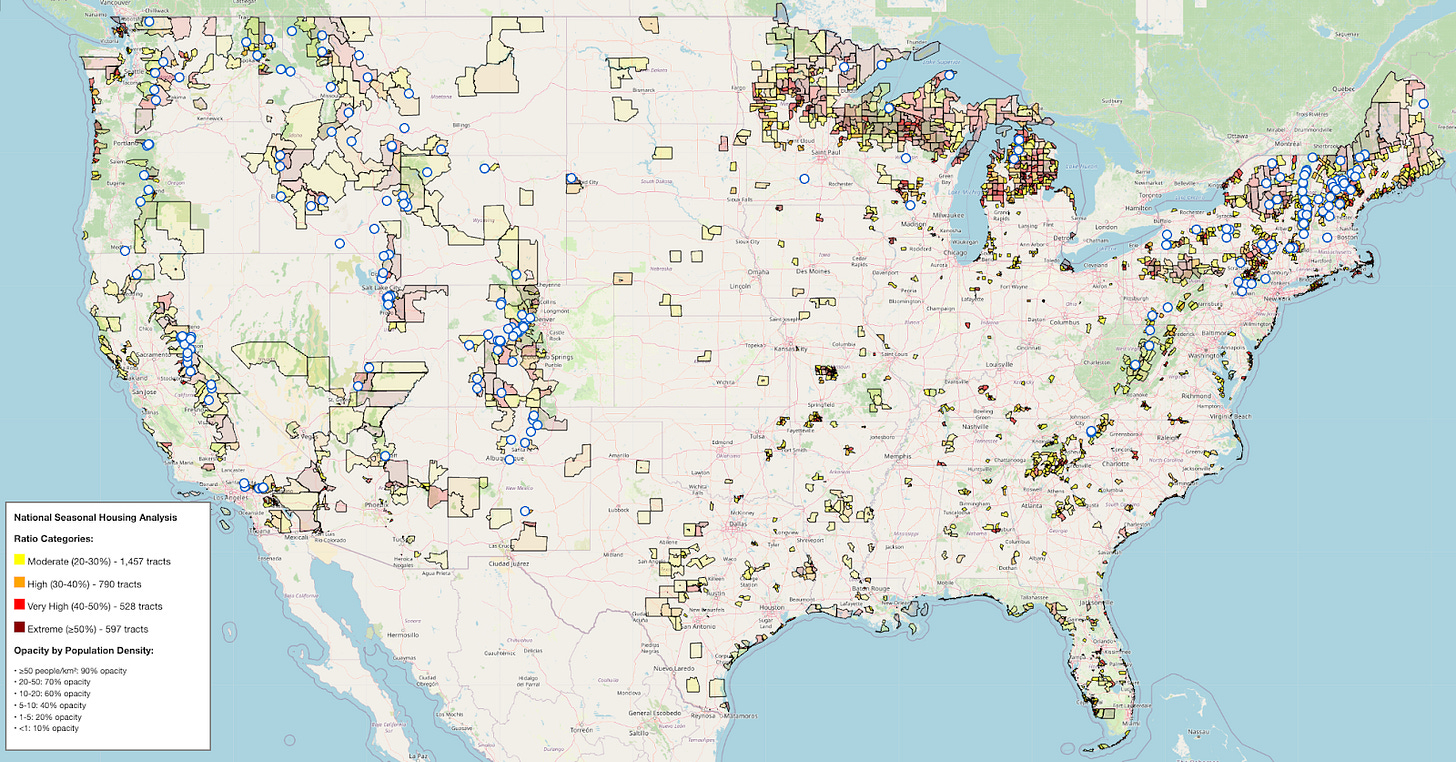
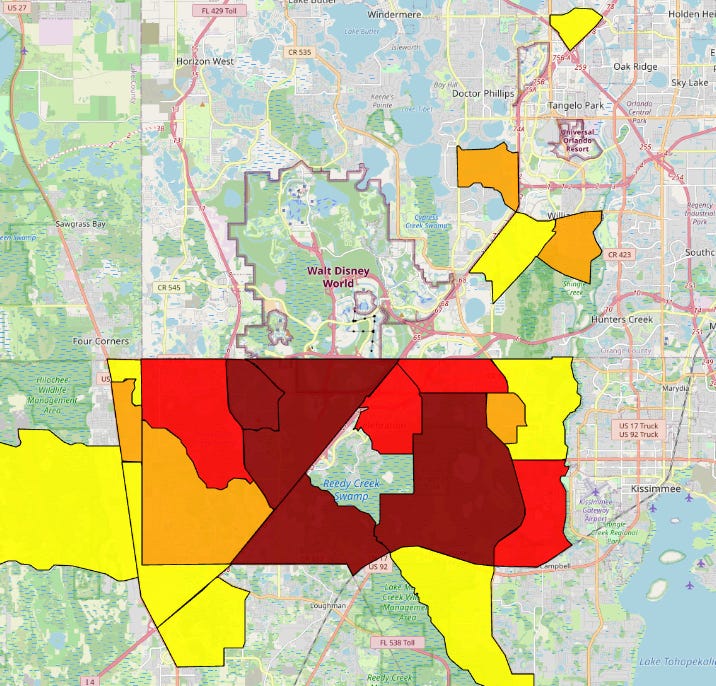
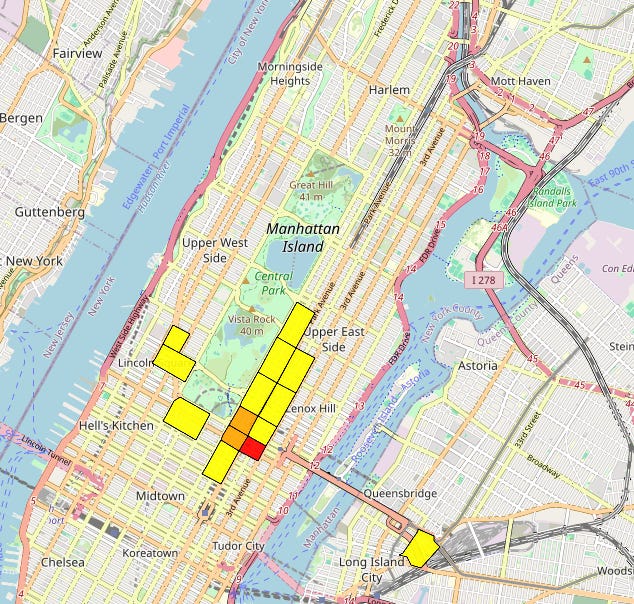
I believe I know why California has fewer costal vacation homes than Florida and the East coast. The state’s costal commission (the same one that Elon Musk got into a legal tiff with) is extremely NIMBY and makes all sorts of construction hard, even by CA standards. Pair that with a complete ban on the construction of houses on the beach that was put in place back in the 70s, and there’s a cap on the most desirable vacation homes, along with a challenging environment for building houses near the ocean.
the "vacation homes" in Manhattan are 8- and 9-figure condos that serve as pied a terres (or straight up investment vehicles) for the ultra wealthy who don't have them as primary residences to avoid NYC income income tax